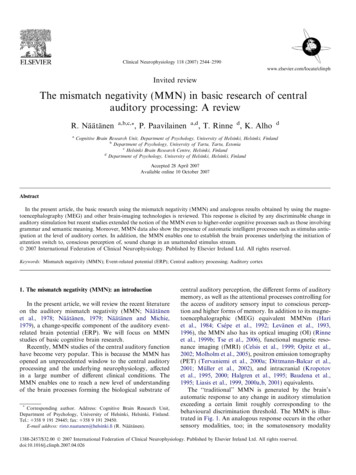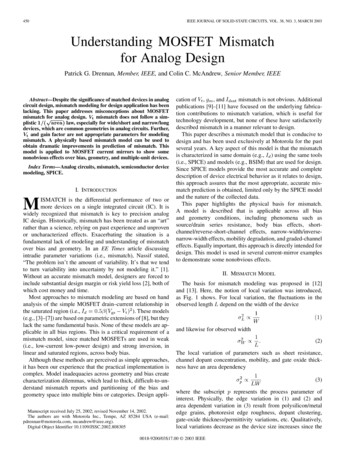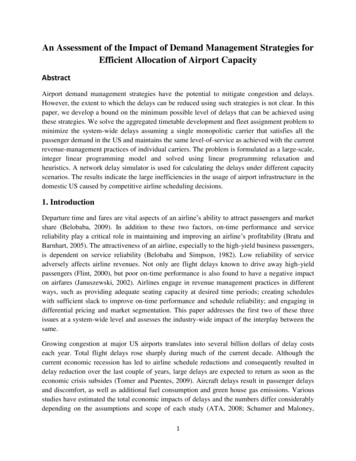
Transcription
Clinical Neurophysiology 118 (2007) 2544–2590www.elsevier.com/locate/clinphInvited reviewThe mismatch negativity (MMN) in basic research of centralauditory processing: A reviewR. Näätänenaa,b,c,*, P. Paavilainena,d, T. Rinne d, K. AlhodCognitive Brain Research Unit, Department of Psychology, University of Helsinki, Helsinki, FinlandbDepartment of Psychology, University of Tartu, Tartu, EstoniacHelsinki Brain Research Centre, Helsinki, FinlanddDepartment of Psychology, University of Helsinki, Helsinki, FinlandAccepted 28 April 2007Available online 10 October 2007AbstractIn the present article, the basic research using the mismatch negativity (MMN) and analogous results obtained by using the magnetoencephalography (MEG) and other brain-imaging technologies is reviewed. This response is elicited by any discriminable change inauditory stimulation but recent studies extended the notion of the MMN even to higher-order cognitive processes such as those involvinggrammar and semantic meaning. Moreover, MMN data also show the presence of automatic intelligent processes such as stimulus anticipation at the level of auditory cortex. In addition, the MMN enables one to establish the brain processes underlying the initiation ofattention switch to, conscious perception of, sound change in an unattended stimulus stream.Ó 2007 International Federation of Clinical Neurophysiology. Published by Elsevier Ireland Ltd. All rights reserved.Keywords: Mismatch negativity (MMN); Event-related potential (ERP); Central auditory processing; Auditory cortex1. The mismatch negativity (MMN): an introductionIn the present article, we will review the recent literatureon the auditory mismatch negativity (MMN; Näätänenet al., 1978; Näätänen, 1979; Näätänen and Michie,1979), a change-specific component of the auditory eventrelated brain potential (ERP). We will focus on MMNstudies of basic cognitive brain research.Recently, MMN studies of the central auditory functionhave become very popular. This is because the MMN hasopened an unprecedented window to the central auditoryprocessing and the underlying neurophysiology, affectedin a large number of different clinical conditions. TheMMN enables one to reach a new level of understandingof the brain processes forming the biological substrate of*Corresponding author. Address: Cognitive Brain Research Unit,Department of Psychology, University of Helsinki, Helsinki, Finland.Tel.: 358 9 191 29445; fax: 358 9 191 29450.E-mail address: risto.naatanen@helsinki.fi (R. Näätänen).central auditory perception, the different forms of auditorymemory, as well as the attentional processes controlling forthe access of auditory sensory input to conscious perception and higher forms of memory. In addition to its magnetoencephalographic (MEG) equivalent MMNm (Hariet al., 1984; Csépe et al., 1992; Levänen et al., 1993,1996), the MMN also has its optical imaging (OI) (Rinneet al., 1999b; Tse et al., 2006), functional magnetic resonance imaging (fMRI) (Celsis et al., 1999; Opitz et al.,2002; Molholm et al., 2005), positron emission tomography(PET) (Tervaniemi et al., 2000a; Dittmann-Balcar et al.,2001; Müller et al., 2002), and intracranial (Kropotovet al., 1995, 2000; Halgren et al., 1995; Baudena et al.,1995; Liasis et al., 1999, 2000a,b, 2001) equivalents.The ‘‘traditional’’ MMN is generated by the brain’sautomatic response to any change in auditory stimulationexceeding a certain limit roughly corresponding to thebehavioural discrimination threshold. The MMN is illustrated in Fig. 1. An analogous response occurs in the othersensory modalities, too; in the somatosensory modality1388-2457/ 32.00 Ó 2007 International Federation of Clinical Neurophysiology. Published by Elsevier Ireland Ltd. All rights reserved.doi:10.1016/j.clinph.2007.04.026
R. Näätänen et al. / Clinical Neurophysiology 118 (2007) 2544–2590MMN as a Function of Frequency ChangeDifferenceFzDeviant1004 Hz1004 Hz1008 Hz1008 Hz1016 Hz1016 HzMMN1032 Hz1032 HzS5V 200400 msS200400 msdeviantstandard (1000 Hz)Fig. 1. (Left) Frontal (Fz) event-related potentials (ERPs) (averagedacross subjects) to randomized 1000 Hz standard (80%, black line) and todeviant (20%, green line) stimuli of different frequencies (as indicated onthe left side). (Right) The difference waves obtained by subtracting thestandard stimulus ERP from that of the deviant stimulus for the differentdeviant stimuli. Subjects were reading a book. Adapted, with permission,from Sams et al. (1985a).(Kekoni et al., 1997; Shinozaki et al., 1998; Akatsuka et al.,2005, 2007), in the olfactory modality (Krauel et al., 1999;for a review, see Pause and Krauel, 2000), and in the visualmodality (Alho et al., 1992; Tales et al., 1999; Heslenfeld,2003; Maekawa et al., 2005; Fu et al., 2003; Czigleret al., 2002, 2004; Pazo-Alvarez et al., 2003; Stagg et al.,2004; Astikainen et al., 2004; see, however, Kenemanset al., 2003; Kimura et al., 2005, and Nyman et al., 1990;for reviews, see Pazo-Alvarez et al., 2003; Maekawaet al., 2005, and Czigler, in press).Moreover, the MMN is also elicited by different kinds ofabstract changes in auditory stimulation such as grammarviolations in mother-tongue sentences – these higher-orderMMNs will be reviewed in later sections of this article.The MMN response is seen as a negative displacementin particular at the frontocentral and central scalp electrodes (relative to a mastoid or nose reference electrode)in the difference wave obtained by subtracting the eventrelated potential (ERP) to frequent, ‘‘standard’’, stimulifrom that to deviant stimuli. Here one has to take intoaccount the possible differences in the obligatory ERPsbetween standards and deviants, however. These differences may result from physical stimulus differences betweenstandards and deviants and from differences in the refractoriness of the neural populations activated by the two stimuli because of the probability difference (see Walker et al.,2001). These differences in the obligatory components are,in general, rather small in amplitude and mainly involvethe N1 time zone, however; therefore post-N1 measure-2545ments of the MMN usually provide quite reliable estimatesof the ‘‘genuine’’ MMN. In addition, the MMN usuallyreverses polarity in nose-referenced mastoid recordings.See also Deacon et al. (2000).The MMN usually peaks at 150–250 ms from changeonset, with this peak latency getting shorter with theincreasing magnitude of stimulus change (Sams et al.,1985a, Tiitinen et al., 1994; Näätänen et al., 1989a,b; Amenedo and Escera, 2000). A prerequisite of MMN elicitation isthat the central auditory system has, before the occurrenceof the deviant stimulus, been able to form a representationof the repetitive aspects of auditory stimulation (Winkleret al., 1996a,b; Horváth et al., 2001; see also Winkleret al., 1999a,b; Huotilainen et al., 1993; Paavilainen et al.,1993a; for a review, see Näätänen and Winkler, 1999). AnMMN is then elicited by a stimulus that violates this representation. The majority of studies used simple paradigms inwhich frequent and infrequent stimuli (e.g., tones of 1000and 1100 Hz, respectively) were presented in a randomorder, with the infrequent sound eliciting an MMN (Näätänen et al., 1978; Sams et al., 1985a). The MMN can, however, also be elicited by changes in complex stimuli suchas speech sounds (Dehaene-Lambertz, 1997; Näätänenet al., 1997) and even by stimuli that deviate from anabstract rule followed by the ongoing auditory stimulationsuch as a tone repetition in a sequence of descending tones(Tervaniemi et al., 1994a); i.e., even when there is no acoustically constant standard stimulus (see Fig. 2).Very importantly, in particular in view of the clinicaland other potential applications, the MMN is elicited irrespective of the subject or patient’s direction of attention(Näätänen, 1979, 1985; Näätänen et al., 1978). Hence, nobehavioural task is needed; in fact, such tasks are used todirect the subject’s attention away from the MMN-elicitingstimulus sequence in order to prevent the elicitation ofattention-dependent ERP components (e.g., the N2b;Renault and Lesévre, 1978, 1979; Näätänen et al., 1982;Sams et al., 1985a, 1990; Novak et al., 1990, 1992; for areview, see Näätänen and Gaillard, 1983) overlapping theMMN.The MMN gets a contribution from at least two intracranial processes: (1) a bilateral supratemporal processgenerating the supratemporal MMN subcomponent (andthe polarity-reversed ‘‘MMN’’ in nose-referenced mastoidrecordings), and (2) a predominantly right-hemisphericfrontal process, generating the frontal MMN subcomponent (Näätänen et al., 1978; Giard et al., 1990; Baldeweget al., 1999; Rinne et al., 2000). The supratemporal component is, presumably, associated with pre-perceptual changedetection, whereas the frontal component appears to berelated to involuntary attention switch caused by auditorychange (Näätänen et al., 1978; Näätänen and Michie, 1979;Giard et al., 1990; Rinne et al., 2000; Escera et al., 1998;Schröger, 1996a,b). The MMN generators reflect the nature of the stimulus, e.g., they usually are left lateralizedfor language stimuli (Näätänen et al., 1997; Shtyrovet al., 2005; Pulvermüller et al., 2003).
2546R. Näätänen et al. / Clinical Neurophysiology 118 (2007) 2544–2590MMN to trend violation (descending standards)baCc )S in u s o idtonesia l toSinusoidalShepard tonesRepeating deviant-1-1µVµVAscending deviantFzFzFz300 msTervaniemi et al., 1994Fig. 2. (a) Spectrum of an individual Shepard sound that, when presentedin ascending or descending sequences of 12 sounds in one semitone step,causes a pitch to ascend or descend in an endless manner. One Shepardsound consists of 10 frequency components, of one octave apart, with a bellshaped spectrum. While a 12-tone series of Shepard sounds is delivered, thetone-height (which is equivalent to the sense of octave) perception is madeto disappear by manipulating the sound spectrum. (b) A visual analogy ofthe Shepard illusion, the endlessly ascending or descending stairs. (c) TheERPs recorded at the frontal (Fz) elecrode from reading subjects to Shepard(left) and sinusoidal (right) tones (thin line: standard stimulus; thick line:deviant stimulus). The left column shows a regularly descending Shepardsound sequence randomly replaced by a repeating (top) or an ascending(bottom) tone (deviant). The right column: regularly descending sinusoidaltone sequence with occasional repetitive (top) or ascending (bottom)deviants. The arrow indicates the deviant-stimulus onset and the shadowedarea the statistically significant part of the mismatch negativity. Adapted,with permission, from Tervaniemi et al. (1994a).2. Memory dependence of MMN elicitationThe MMN depends on the presence of a short-termmemory trace in the auditory cortex representing the repetitive aspects of the preceding auditory events, which usually lasts for a few seconds. Therefore, single sounds,even deviants, with no preceding sounds during the lastfew seconds elicit no MMN but rather enhanced obligatoryresponses P1, N1, and P2 (Näätänen and Picton, 1987;Korzyukov et al., 1999). Hence, the MMN seen in the difference wave delineated by subtracting the standard-stimulus ERP from that to the deviant stimulus is not simply dueto a larger exogenous response to an infrequent than frequent stimulus (for a review, see Näätänen et al., 2005).The MMN is rather composed of, at least mainly, the outcome of a discrimination process where the deviant event isfound to be discongruent with the memory representationof the preceding stimuli (even in the absence of attention).However, as already mentioned, fresh afferent neuralpopulations activated by deviant stimuli such as those of aclearly different frequency often contribute to the difference-wave negativity, usually to its early part (the N1 timezone Näätänen et al., 1988). Moreover, standards and deviants might elicit different exogeneous responses even wheneach is presented alone in a stimulus block (e.g., tones ofvery different frequency or duration; for a review, see Näätänen and Picton, 1987). For this reason, the difference wave isoften formed by subtracting the ERP to a given stimuluswhen it is presented as a standard in one stimulus block fromthat elicited by the same stimulus when it is presented as adeviant in another block (e.g., Deacon et al., 2000).Furthermore, a controlled protocol, introduced bySchröger and Wolff (1996), can be used for disentanglingthe N1 and ‘genuine’ MMN components from oneanother. It allows one to separate the N1 and MMN mechanisms, for instance by controlling for differential states ofrefractoriness of the feature-specific afferent neurons in theMMN to frequency changes (Jacobsen and Schröger,2001). Similar results were obtained for MMNs to changesin location, duration, and intensity (Schröger and Wolff,1996; Jacobsen and Schröger, 2003; Jacobsen et al.,2003a, see also Jacobsen et al., 2003b). These studies yieldstrong evidence for the memory-based comparison accountof the MMN.The memory-trace interpretation is supported, amongother things, also by results as follows (for a review, seeNäätänen et al., 2005):(1) The lack of any MMN-type of response to the firststimulus of a sequence (Cowan et al., 1993; Samset al., 1985b) or to stimuli, either standards or deviants, presented with very long inter-stimulus intervals(ISIs) (Mäntysalo and Näätänen, 1987; Näätänenet al., 1987a; Kraus et al., 1993a,b; for a review, seeSokolov et al., 2002). Thus, the MMN is not elicitedper se by any stimulus, without a few preceding repetitions of a different stimulus (standard) precedingthis stimulus. This indicates that a response to therelation of the present stimulus to the representationof the preceding stimuli is involved;(2) the MMN elicited by a decrement of stimulus duration (Näätänen et al., 1989b; Paavilainen et al.,1991; Kaukoranta et al., 1989), ISI (Ford and Hillyard, 1981; Nordby et al., 1988b; Hari et al., 1989a;Näätänen et al., 1993c; Rüsseler et al., 2001), or stimulus intensity (Fig. 3). These large, long-durationMMNs cannot be explained by new afferent neurons;(3) the MMN elicited by the omission of an element of acompound stimulus (Nordby et al., 1991; Winklerand Näätänen, 1993), stimulus omission in a stimulussequence presented at a very fast constant rate (Yabeet al., 1997, 1998; Rüsseler et al., 2001), or by theomission of the second of two paired stimuli repetitively presented with a short constant stimulus-onsetasynchrony (SOA) (Tervaniemi et al., 1994b);
R. Näätänen et al. / Clinical Neurophysiology 118 (2007) 2544–2590MMN to intensity decrement and incrementDeviant(dB SPL)FpzFzCzPz577077839095-5 µVS200 msStandard (80dB)DeviantNäätänen 1992Fig. 3. Grand-avarage frontal-pole (Fpz), frontal (Fz), central (Cz), andparietal (Pz) difference waves obtained by subtracting the response elicitedby the 80-dB standard tone from the responses elicited by devaint tones of 6different intensity levels presented in separate blocks. The N1 latency ismarked to point out that whereas the N1 amplitude increases with increasingdeviant-tone intensity (independent of the standard-tone intensity), themismatch negativity (MMN) amplitude increases and the MMN peaklatency decreases with increasing magnitude of deviation from the standard(i.e., for deviants being both louder and softer than the standard). FromAttention and Brain Function (p. 142) by R. Näätänen, 1992. Copyright 1992Lawrence Erlbaum Associates, Inc. Reprinted with permission.(4) the long peak latency and duration of the MMN inparticular for minor stimulus changes (e.g., Näätänenet al., 1989a,b) or for changes in complex sounds suchas speech sounds, which are atypical to the afferentresponses (e.g., Näätänen et al., 1997);(5) the generator-loci differences between the N1 (and theother afferent responses) and the MMN, to bereviewed later;(6) the differential sensitivity of the MMN and the afferent responses to different manipulations such as theadministration of an NMDA-receptor antagonist(Javitt et al., 1996; Umbricht et al., 2002);(7) the very different developmental trajectories of theN1 (Kurtzberg et al., 1995; Pang and Taylor, 2000)and the MMN: in contrast to the N1, the MMNcan be recorded in newborns (Alho et al., 1990) andeven before (Draganova et al., 2005; Huotilainenet al., 2005).2547(8) the different generator constellations underlyingMMNs elicited by stimuli yielding higher-level cognitive processes. These MMN-generator constellationsare in a surprisingly good agreement with the brainactivation patterns seen during the respective cognitive processes. For example, the MMN elicited bysyntactic errors shows activation in left perisylvianareas where syntactic processing is known to behoused, and the generators of semantic MMN activity agree with the brain loci of semantic memory networks revealed by a range of neuroimagingexperiments (for a review, see Pulvermüller and Shtyrov, 2006).These findings belong to the central evidence for thecognitive or memory interpretation of the MMN: it is elicited when the sensory input does not ‘‘match with’’ the representation of the preceding standard stimuli (see alsoLaufer and Pratt, 2005). Thus, in recording the MMN todeviant stimuli, one appears to be probing the neural representation of the standard stimulus, with the MMNresponse reflecting the detection of a difference betweenthe deviant and standard auditory events and hence providing an objective index for auditory discrimination accuracy. Therefore, the MMN also provides, indirectly, ameasure of the accuracy of the neural representation ofthe standard stimulus (see Näätänen and Alho, 1997). Consequently, the MMN opens a unique window to the perceptual and memory functions of the auditory cortex.The sensory information carried by the sensory-memorytraces underlying the MMN generation indeed correspondsto sound perception and memory (and thus provides thecentral sound representation, CSR), rather than just tothe acoustic elements composing the stimulus (Näätänenand Winkler, 1999). This was demonstrated, e.g., by Winkler et al. (1995) who found an MMN to a change of themissing fundamental, with both the standards and deviantsbeing composed of varying combinations of the same simple tonal elements.The results of several studies adding a backward-masking stimulus to the oddball paradigm (Winkler et al., 1992,1993; Bazana and Stelmack, 2002) also suggested that theMMN reflects sensory (echoic) memory in audition (forreviews of different forms of auditory sensory memory,see Cowan, 1988; see also Winkler and Cowan, 2004), withthe traces underlying this memory being probed by presenting deviant stimuli (for a review, see Näätänen andWinkler, 1999).As already mentioned, traces of a relatively short duration are involved in MMN generation (see, however,Cowan et al., 1993; Atienza et al., 2001, 2004; Jääskeläinenet al., 1999a; Winkler and Cowan, 2004; Winkler et al.,1996a,b). In young, healthy subjects, these traces can lastfor about 5–10 s, judging from the ISIs that still permitMMN elicitation (Böttcher-Gandor and Ullsperger, 1992,Näätänen et al., 1987a; Mäntysalo and Näätänen, 1987;Sams et al., 1993; see also Ritter et al., 2002), but the trace
2548R. Näätänen et al. / Clinical Neurophysiology 118 (2007) 2544–2590duration gets shorter with aging (Jääskeläinen et al., 1999b;Pekkonen et al., 1996). Furthermore, this age-dependentshortening of the memory trace is expedited by chronicalcoholism (Polo et al., 1999; Grau et al., 2001), and thesetraces are very short in duration in patients with neurodegenerative brain diseases such as Alzheimer’s disease(Pekkonen et al., 1994, Pekkonen, 2000). Grau et al.(1998) developed a new paradigm to determine the duration of these traces in a much shorter time than is usuallyneeded.In the beginning of a stimulus block, the standard stimulus has to be repeated for a few times before a deviantstimulus can elicit an MMN (Cowan et al., 1993; Winkleret al., 1996a,b). In addition, the MMN amplitude gets larger with the increasing number of standards preceding adeviant (Sams et al., 1983; Imada et al., 1993a,b; Baldeweget al., 2004; Haenschel et al., 2005; Javitt et al., 1998). TheMMN elicitation early in a block may, however, be facilitated by the standard stimulus of the block being identicalto that of the preceding block (Cowan et al., 1993; Winkleret al., 1996a,b). This suggests that the sensory-memorytraces probed with the MMN in the traditional passiveoddball paradigm might yield a conservative estimate ofthe duration of the short-term sensory memory trace inaudition (see also Winkler and Cowan, 2004; Winkler, Kujala et al., 2003a). Moreover, subsequent studies showedthat the MMN can also be used for probing long-term orpermanent memory traces in audition such as those servingspeech perception or the recognition of familiar voices, aswill be reviewed later in this article.In addition, the rate at which standards are presented isof course of importance to trace formation and maintenance. With shorter ISIs between the standards, theMMN amplitude tends to get larger (Näätänen et al.,1987a; Sabri and Campbell, 2001; Javitt et al., 1998; seealso Alain et al., 1994). For corroborating fMRI data,see Sabri et al. (2004).3. Deviant-stimulus probabilityThe MMN amplitude is decreased by increasing thedeviant-stimulus probability (Näätänen et al., 1987a; Ritteret al., 1992; Sabri and Campbell, 2001; Haenschel et al.,2005; Sato et al., 2000, 2002). This is partially due to thestandard-stimulus being more often replaced by deviantstimuli (and cannot then contribute to trace strength) thanthey are with smaller deviant-stimulus probabilities. Amore important factor, however, appears to be the fact thatwith shorter deviant-stimulus intervals, these stimulidevelop a trace of their own, which in turn might inhibitMMN generation with regard to the initial standard (Samset al., 1984; Ritter et al., 1992; Rosburg, 2004; Rosburget al., 2004a,b). In fact, an early account of the MMN(Näätänen, 1984) explained the MMN phenomenon interms of the input from the eliciting deviant stimulus‘‘starting’’ to develop the representation of its own in theauditory sensory-memory system already engaged by therepresentation of the preceding stimuli (cf. Donchin’s influential context-updating hypothesis of the P3 (Sutton et al.,1965); Donchin, 1981; Karis et al., 1984; Donchin andColes, 1988, 1991; see also Javitt et al., 1996; Winkleret al., 1996a,b; Sussman and Winkler, 2001). Subsequently,three different studies (Sato et al., 2000, 2002; Haenschelet al., 2005) found that the frontally recorded MMN ismore sensitive to probability manipulation than is the auditory-cortex source (recorded from the mastoid with nosereference; see a later section).When two deviants happen to occur in a row, then theMMN to the second deviant is smaller in amplitude thanthat to the first deviant (Sams et al., 1984; Müller et al.,2005b).The reduction of MMN amplitude is markedlysmaller, if the second of two successive deviants deviatesfrom standards in a different attribute than the first deviant(Müller et al., 2005b; Nousak et al., 1996).3.1. Separation of the MMN from the other componentsAs already concluded, the MMN cannot be accountedfor by the enhancement of the exogenous N1 even thoughthe MMN usually overlaps, at least partially, the N1 whenthe magnitude of stimulus change exceeds a certain limit(Tiitinen et al., 1994; for a review, see Näätänen et al.,2005). As already mentioned, MEG recordings indicatethat the supratemporal source of the MMN can be separated from the N1 source. These studies will be reviewedlater. Moreover, robust MMNs (or analogous slow positive waves; Ruusuvirta et al., 2003; Winkler, Kujalaet al., 2003a; Maurer et al., 2003a,b) to various kinds ofauditory change can be recorded even in newborns inwhom no well-defined N1-type of response is elicited (Alhoet al., 1990; Cheour et al., 2002a,b,c; Pang and Taylor,2000). In addition, almost normal-size MMNs to a changein a complex spectrotemporal stimulus, reflecting the effectof prior discrimination training, were present 3 days laterin REM sleep in which the N1 was almost completely abolished (Atienza and Cantero, 2001). Moreover, drug effectson the N1 and MMN amplitudes can be very different (e.g.,Javitt et al., 1996). In addition, certain lesions may eliminate the MMN but leave the N1 intact (e.g., Alho et al.,1994b). Also, subjects can be trained to perform an initiallyvery difficult discrimination, which is accompanied by theemergence and growth of the MMN with no correspondingeffect on the N1 (Atienza et al., 2002b; Näätänen et al.,1993b).When the sequence of standard and deviant sounds isattended, then the MMN is usually elicited quite similarlyas when the subject’s attention is directed elsewhere (eventhough under some conditions with highly focused attention elsewhere, its amplitude may, as will be discussed later,be somewhat attenuated). However, when a sound streamis attended, then the MMN elicited by deviants in thisstream is at least partially overlapped by the N2b (Näätänen et al., 1982; for a review, see Näätänen and Gaillard,1983), with a scalp distribution somewhat posterior to that
R. Näätänen et al. / Clinical Neurophysiology 118 (2007) 2544–2590of the MMN (Aulanko et al., 1993). Furthermore, unlikethe MMN, which usually shows a polarity reversal whenrecorded from mastoid electrodes with nose reference, theN2b shows no such polarity reversal. Hence, the mastoidrecordings can provide an estimate of the supratemporalcomponent of the MMN without N2b contamination.The processing negativity (PN) elicited by an attendedstimulus stream in the presence of a concurrent irrelevantstimulus stream (Näätänen et al., 1978; Alho et al., 1987;Näätänen, 1988, 1990; see also Hillyard et al., 1973; Hansen and Hillyard, 1983; for an MEG equivalent of thePN, see Hari et al., 1989b) may also overlap the MMNin response to deviants in the attended stimulus stream.The PN is, however, cancelled in the difference wavesobtained by subtracting the ERP to standards from thatto deviants within the attended channel (Alho et al.,1987). [Hansen and Hillyard’s (1983) ‘‘Nd’’ refers to thePN difference between ERPs to attended and unattendedstimulus streams; see Alho et al., 1987.]3.2. MMN generatorsThe scalp-recorded MMN has its largest amplitude overthe fronto-central scalp areas. The modeling of the generator sources of the MMN with equivalent current dipoles(ECD) suggests that the fronto-centrally predominantscalp distribution of the MMN is mainly explained bythe sum of the activity bilaterally generated in the supratemporal cortices (Giard et al., 1995; Rinne et al., 1999b;Scherg et al., 1989; Jemel et al., 2002). This interpretationis supported by MMNm recordings (Hari et al., 1984;Levänen et al., 1996; Alho et al., 1998a,b; Sams et al.,1991b; Csépe et al., 1992) which show signal maxima overthe bilateral supratemporal cortices.Moreover, intracranial MMN recordings in the mouse(Umbricht et al., 2005), guinea pig (Kraus et al., 1994a,b;King et al., 1995), cat (Csépe et al., 1987, 1988, 1989;Csépe, 1995; Pincze et al., 2001, 2002), rat (Ruusuvirtaet al., 1998; Astikainen et al., 2006; see, however, Erikssonand Villa, 2005; Lazar and Metherate, 2003), rabbit (Astikainen et al., 2000), monkey (Javitt et al., 1992, 1996), andhumans (Halgren et al., 1995, 1998; Baudena et al., 1995;Kropotov et al., 1995, 2000; Liasis et al., 1999, 2000a,2001; Rosburg et al., 2005) indicated MMN generation inthe auditory cortex. These results also showed that theMMN generation locus can be separated from those ofthe N1 and the other afferent responses. For example, inhumans, the MMNm to frequency change is generated inthe supratemporal cortex 3–10 mm anteriorly to the N1msource (Sams et al., 1991b; Csépe et al., 1992; Hari et al.,1992; Huotilainen et al., 1993; Tiitinen et al., 1993; Levänen et al., 1993, 1996; Liasis et al., 2000a; Alho et al.,1998a,b; Korzyukov et al., 1999; Rosburg, 2003; Rosburget al., 2004a; see also Rosburg et al., 2004b). A similar difference was also observed in the source localization of theelectrically recorded MMN and N1 (Scherg et al., 1989).2549Optical recordings (Rinne et al., 1999b), too, show a clearseparation between the N1 and MMN generators.In addition, intracranial recordings in humans (Kropotov et al., 1995, 2000; Rosburg, 2003) indicate that theMMN to deviant sounds among standard sounds and theenhanced N1 response to infrequent sounds occurring withno intervening standard sounds are generated by differentneuronal populations. Kropotov et al. (2000) found thatone area of the temporal cortex (Area, 22) gave a differential response to deviants (1300-Hz tone) among standards(1000-Hz tone) in the MMN latency range, but did notrespond differentially to these tones when each of themwas presented alone in a sequence, and did not respond differentially to the 1000-Hz standard tone when it was(alone) presented at a slow (deviant-stimulus) rate or at afast (standard-stimulus) rate. In contrast, frequency-dependent responses were recorded from Area 41 and responsesto rarity per se (i.e., a larger response to deviants alone attheir typical long intervals than the response to these stimuli alone at short intervals) from Area 42 (cf. Ulanovskyet al., 2003). Hence, the existence of genuine change-dependent responses could be verified and their cortical originseparated from that of the cortical reception of the afferentinput that gives rise to the frequency- and rate-specific cortical afferent responses such as the N1 (N1a; see Näätänenand Picton, 1987). For supporting evidence, see Liasis et al.(1999, 2000a,b).Intracranial animal data also support the separability ofthe MMN from the afferent responses. On the basis of th
Invited review The mismatch negativity (MMN) in basic research of central auditory processing: A review R. Na a ta nen a,b,c,*, P. Paavilainen a,d, T. Rinne d, K. Alho d a Cognitive Brain Research Unit, Department of Psychology, University of Helsinki, Helsinki, Finland b Department of Psychology, University of Tartu, Tartu, Estonia c Helsinki Brain Research Centre, Helsinki, Finland










